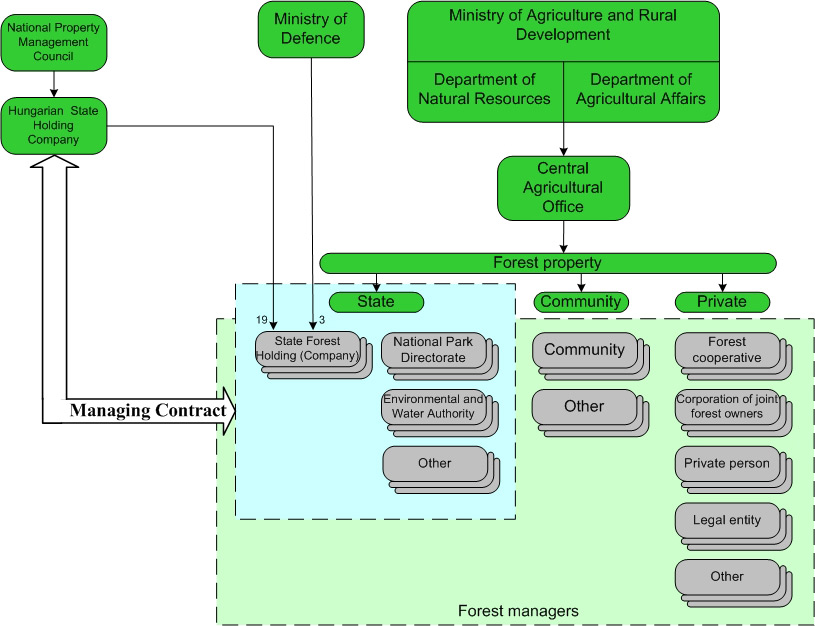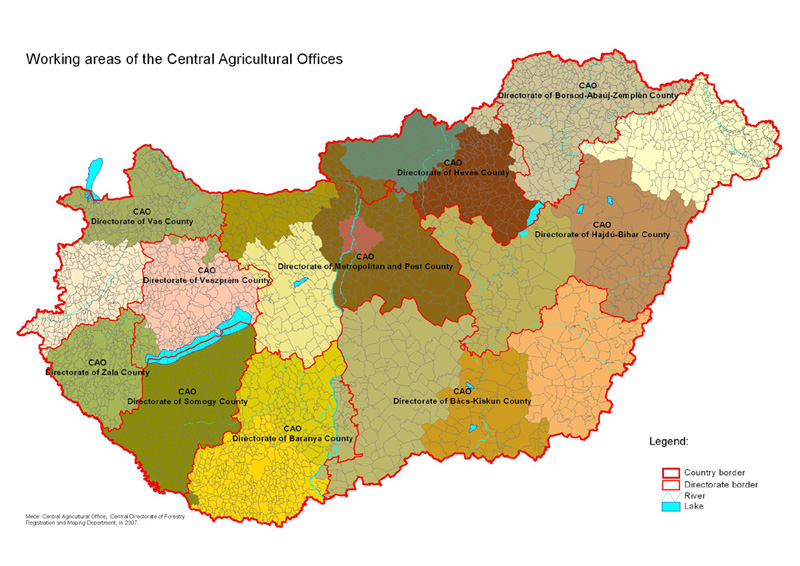Introduction

Dear Visitor! Let us introduce the system of the Hungarien Forest Management, and the structure and activities of the National Food Chain Safety Office:
Construction of forestry administration
About 25% of the arable soil of the country is utilized by forest management. The national economic importance of the sector is inevitable as forests are there in our natural and constructed environment as well.
Even though the sectors receive considerably little from the GDP, the size of the area, the large number of owners, managers and employees, the variety of natural relations and the multiple, constantly renewed expectations of society with regards to forests require a professionally founded administrational system.
The current structure of forestry administration has been developed by social and economic changes following the political changes and by the legal background established parallel to this process.
The forest management sector is submitted to the jurisdiction of the Minister of Agriculture and Rural Development. The regulatory and directing tasks are performed by a separate unit within the Ministry, the Department of Natural Resources. Primary and secundary magisterial management, organisation and administrative tasks are performed by the Central Agricultural Office. Regarding the question of management there are state-owned and private forests.

The proprietary rights of state-owned areas by the assignment of the Minister of Finances are practiced by the Hungarian National Asset Management Company. The supervisors of these proprietor is the Minister of Finances.
The Hungarian National Asset Management Company, as proprietor, assigns state-owned forest land areas into the custody of the 100% state-owned, mostly forestry corporations. Other areas are managed by forest managers registered by the forestry authority. Forest managers are private entities or legal persons exercising proprietary rights or the right of use for the area.
Structure of ownership
In Hungary the share of state-owned forests is 56% and that of community-owned is 1% and 43% of forests are private. A long-term purpose, primarily based on afforestation, is the large-scale increase of private and community owned areas. The highlighted objective of forestry policy is the structure improvement of the over-divided estate system that hinders private forest management, and the establishment of viable management organisations and partnerships.
Central Agricultural Office (CAO), purposeful and controlled forest management
The Central Agricultural Office is a central budgetary organization working under the direct control of the Ministry of Agriculture and Rural Development. The organisation comprises nineteen regional offices (on level of county) and a headquarters.
The CAO has a Forestry Directorate int he headquarters and 10 regional Forestry Directorates as part of the county offices. The major purpose of the CAO is the facilitation of purposeful and controlled forest management.
The main tasks are the following:
- Forest inventory on the whole forested area of the country regardless of proprietary relations-, 10-year-recovery middle-term management plans, so called district forest plans
- Basic and thematic mapping
- Management and updating of the National Forest Stand Database
- Collection of data and data processing for statistics
- Coordination of forest health monitoring
- Performance of primary and secondary forestry authority tasks
- Participation in the application procedures related to national and European forestry support.
These tasks are performed by the CAO within the relating legal frames, regardless of the proprietorship of forests or the sector itself. However, as opposed to similar organisations of other European countries, the CAO does not perform silvicultural activities.
Forest management system, tendency
The management of state-owned forests is primarily performed by the 22 forest management corporation under the supervision of the Hungarian National Asset Management Company and the Ministry of Defence. However, other national institutions like water resource directorates, national parks are also managing state-owned forest land areas. The share of community ownership is relatively small, mostly managed by municipalities of villages and cities.
The majority of private forests are undivided joint properties. Regarding management primarily natural persons - employed by assignment contract - are to be mentioned, but the share of corporations and cooperatives is also considerable. A special forest management type is the institution of the integrator that handles forest land areas in one's own right and performs professional directing activities in areas belonging to other forest managers or contracts with them to perform particular forest management tasks. Due to their size unmanaged, "unclaimed" forest land areas must also be mentioned. These areas do not have a responsible forest manager registered at the forestry authority. It is a highlighted purpose of forest administration to decrease their scale by magisterial and supporting means, and to help the establishment and operation of long-term management structures.
Legal background
The legal background of forest management in Hungary is the. Act No. LIV of 1996 on Forests and the Protection of Forests, the decree of 29/1997 (IV. 30.) issued by the Ministry of Agriculture and Rural Development on the execution of the previous and the Ministry decree of 88/2000 (XI.10.) on the Forest Management Planning and Supervision Code. The other law regulating magisterial and administrational tasks is the Act No. CXL of 2004 on state administration procedures. Forestry Directorate observes every other relative law, especially the Act No LIII. of 1996 on Nature Conservation and the Act No. LV. on the Protection of Game, Game Management and Hunting.
